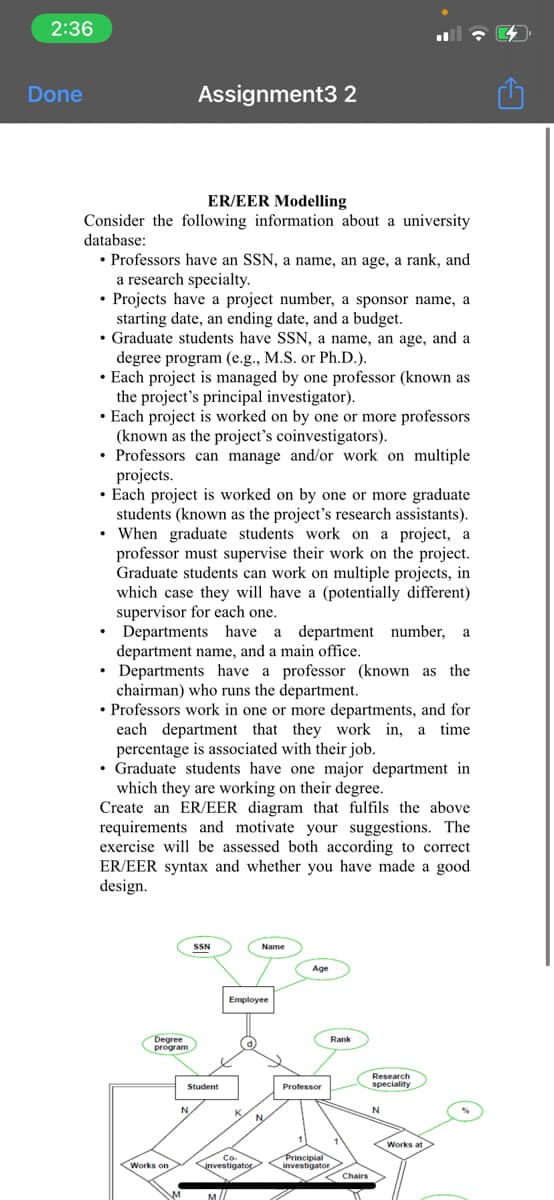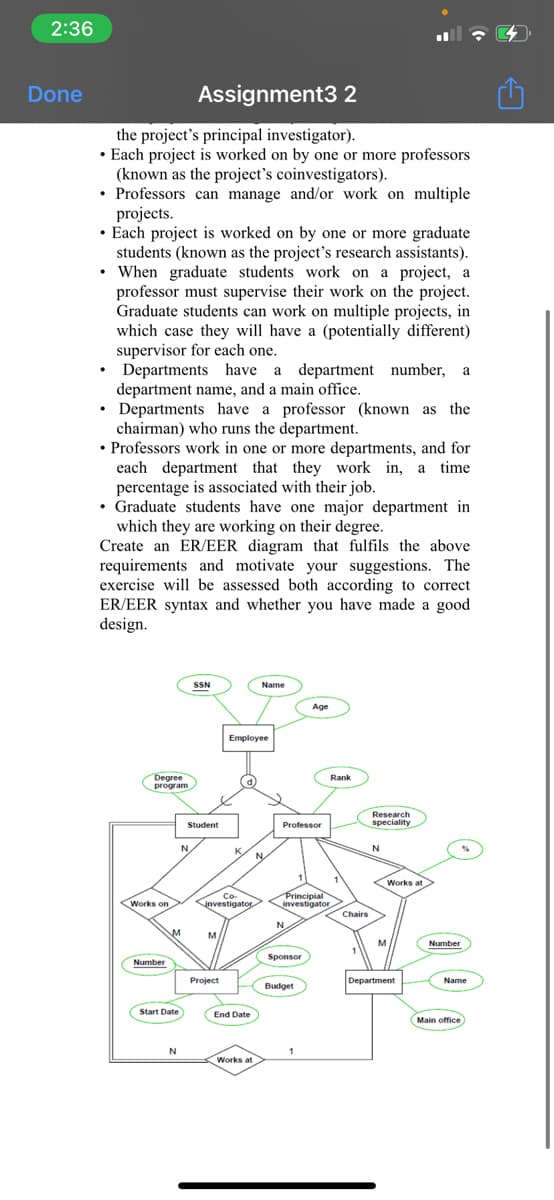Consider the following information about a university database: • Professors have an SSN, a name, an age, a rank, and a research specialty. • Projects have a project number, a sponsor name, a starting date, an ending date, and a budget. • Graduate students have SSN, a name, an age, and a degree program (e.g., M.S. or Ph.D.). • Each project is managed by one professor (known as the project’s principal investigator). • Each project is worked on by one or more professors (known as the project’s coinvestigators). • Professors can manage and/or work on multiple projects. • Each project is worked on by one or more graduate students (known as the project’s research assistants). • When graduate students work on a project, a professor must supervise their work on the project. Graduate students can work on multiple projects, in which case they will have a (potentially different) supervisor for each one. • Departments have a department number, a department name, and a main office. • Departments have a professor (known as the chairman) who runs the department. • Professors work in one or more departments, and for each department that they work in, a time percentage is associated with their job. • Graduate students have one major department in which they are working on their degree. Create an ER/EER diagram that fulfils the above requirements and motivate your suggestions. The exercise will be assessed both according to correct ER/EER syntax and whether you have made a good design
Consider the following information about a university database: • Professors have an SSN, a name, an age, a rank, and a research specialty. • Projects have a project number, a sponsor name, a starting date, an ending date, and a budget. • Graduate students have SSN, a name, an age, and a degree program (e.g., M.S. or Ph.D.). • Each project is managed by one professor (known as the project’s principal investigator). • Each project is worked on by one or more professors (known as the project’s coinvestigators). • Professors can manage and/or work on multiple projects. • Each project is worked on by one or more graduate students (known as the project’s research assistants). • When graduate students work on a project, a professor must supervise their work on the project. Graduate students can work on multiple projects, in which case they will have a (potentially different) supervisor for each one. • Departments have a department number, a department name, and a main office. • Departments have a professor (known as the chairman) who runs the department. • Professors work in one or more departments, and for each department that they work in, a time percentage is associated with their job. • Graduate students have one major department in which they are working on their degree. Create an ER/EER diagram that fulfils the above requirements and motivate your suggestions. The exercise will be assessed both according to correct ER/EER syntax and whether you have made a good design
Computer Networking: A Top-Down Approach (7th Edition)
7th Edition
ISBN:9780133594140
Author:James Kurose, Keith Ross
Publisher:James Kurose, Keith Ross
Chapter1: Computer Networks And The Internet
Section: Chapter Questions
Problem R1RQ: What is the difference between a host and an end system? List several different types of end...
Related questions
Question
Consider the following information about a university database :
• Professors have an SSN, a name, an age, a rank, and a research specialty.
• Projects have a project number, a sponsor name, a starting date, an ending date, and a budget.
• Graduate students have SSN, a name, an age, and a degree program (e.g., M.S. or Ph.D.).
• Each project is managed by one professor (known as the project’s principal investigator).
• Each project is worked on by one or more professors (known as the project’s coinvestigators).
• Professors can manage and/or work on multiple projects.
• Each project is worked on by one or more graduate students (known as the project’s research assistants).
• When graduate students work on a project, a professor must supervise their work on the project. Graduate students can work on multiple projects, in which case they will have a (potentially different) supervisor for each one.
• Departments have a department number, a department name, and a main office.
• Departments have a professor (known as the chairman) who runs the department.
• Professors work in one or more departments, and for each department that they work in, a time percentage is associated with their job.
• Graduate students have one major department in which they are working on their degree.
Create an ER/EER diagram that fulfils the above requirements and motivate your suggestions. The exercise will be assessed both according to correct ER/EER syntax and whether you have made a good design.

Transcribed Image Text:2:36
Done
Assignment3 2
ER/EER Modelling
Consider the following information about a university
database:
• Professors have an SSN, a name, an age, a rank, and
a research specialty.
• Projects have a project number, a sponsor name, a
starting date, an ending date, and a budget.
• Graduate students have SSN, a name, an age, and a
degree program (e.g., M.S. or Ph.D.).
• Each project is managed by one professor (known as
the project's principal investigator).
• Each project is worked on by one or more professors
(known as the project's coinvestigators).
• Professors can manage and/or work on multiple
projects.
• Each project is worked on by one or more graduate
students (known as the project's research assistants).
When graduate students work on a project, a
professor must supervise their work on the project.
Graduate students can work on multiple projects, in
which case they will have a (potentially different)
supervisor for each one.
Departments have a department number, a
department name, and a main office.
Departments have a professor (known as the
chairman) who runs the department.
• Professors work in one or more departments, and for
each department that they work in, a
percentage is associated with their job.
• Graduate students have one major department in
which they are working on their degree.
Create an ER/EER diagram that fulfils the above
requirements and motivate your suggestions. The
exercise will be assessed both according to correct
ER/EER syntax and whether you have made a good
design.
time
SSN
Name
Age
Employee
Degree
program
Rank
Research
speciality
Student
Professon
N
N.
Works at
Principial
investigator
Chairs
Co-
Works on
investigator
M//

Transcribed Image Text:2:36
Done
Assignment3 2
the project's principal investigator).
• Each project is worked on by one or more professors
(known as the project's coinvestigators).
• Professors can manage and/or work on multiple
projects.
• Each project is worked on by one or more graduate
students (known as the project's research assistants).
When graduate students work on a project, a
professor must supervise their work on the project.
Graduate students can work on multiple projects, in
which case they will have a (potentially different)
supervisor for each one.
Departments have a department number,
department name, and a main office.
• Departments have a professor (known as the
chairman) who runs the department.
• Professors work in one or more departments, and for
each department that they work in, a
percentage is associated with their job.
• Graduate students have one major department in
which they are working on their degree.
Create an ER/EER diagram that fulfils the above
requirements and motivate your suggestions. The
exercise will be assessed both according to correct
ER/EER syntax and whether you have made a good
design.
a
time
SSN
Name
Age
Employee
Degree
program
Rank
Research
speciality
Student
Professor
N
K/
N
Works at
Principial
<investigator investigator
Chairs
Co
<Works on
N
M
Number
Sponsor
Number
Project
Department
Name
Budget
Start Date
End Date
Main office
N
1
Works at
Expert Solution
This question has been solved!
Explore an expertly crafted, step-by-step solution for a thorough understanding of key concepts.
This is a popular solution!
Trending now
This is a popular solution!
Step by step
Solved in 3 steps with 1 images

Recommended textbooks for you

Computer Networking: A Top-Down Approach (7th Edi…
Computer Engineering
ISBN:
9780133594140
Author:
James Kurose, Keith Ross
Publisher:
PEARSON

Computer Organization and Design MIPS Edition, Fi…
Computer Engineering
ISBN:
9780124077263
Author:
David A. Patterson, John L. Hennessy
Publisher:
Elsevier Science

Network+ Guide to Networks (MindTap Course List)
Computer Engineering
ISBN:
9781337569330
Author:
Jill West, Tamara Dean, Jean Andrews
Publisher:
Cengage Learning

Computer Networking: A Top-Down Approach (7th Edi…
Computer Engineering
ISBN:
9780133594140
Author:
James Kurose, Keith Ross
Publisher:
PEARSON

Computer Organization and Design MIPS Edition, Fi…
Computer Engineering
ISBN:
9780124077263
Author:
David A. Patterson, John L. Hennessy
Publisher:
Elsevier Science

Network+ Guide to Networks (MindTap Course List)
Computer Engineering
ISBN:
9781337569330
Author:
Jill West, Tamara Dean, Jean Andrews
Publisher:
Cengage Learning

Concepts of Database Management
Computer Engineering
ISBN:
9781337093422
Author:
Joy L. Starks, Philip J. Pratt, Mary Z. Last
Publisher:
Cengage Learning

Prelude to Programming
Computer Engineering
ISBN:
9780133750423
Author:
VENIT, Stewart
Publisher:
Pearson Education

Sc Business Data Communications and Networking, T…
Computer Engineering
ISBN:
9781119368830
Author:
FITZGERALD
Publisher:
WILEY